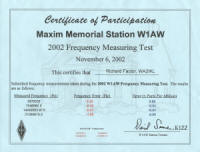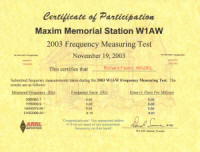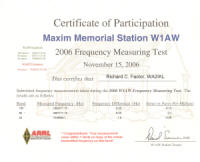RIKLBLOG
|
| Tomorrow |
| 31 May 2007 |
| Yesterday |
| Index |
| Eventide |
| SETI League |
| PriUPS Project |
| Bonus! |
| Contact |
Take That, ARRL
Warning: This is going to be one of those unabashedly nerdy blogitems that I occasionally commit. The subject — frequency measurement — is simultaneously tedious and irrelevant, and it embodies the charm of license plate spotting while stuck in a ten-mile traffic jam. I shall attempt to enliven this at the very end with a linguistic observation (if I remember to) but this is almost certainly doomed to failure, interest-wise.
The ARRL, the American Radio Relay League, is and has been since the beginning of ham (amateur) radio the umbrella organization for its practitioners. A very large percentage of us join, although we are under no obligation to do so, and its magazine, the engagingly titled "QST" is an important historical and technical journal in our radio lives. The ARRL sponsors various activities and promulgates the rules and dates in QST. For example, "Field Day" is coming up, at which time hams will leave their comfortable homes to erect antennas in public parks, farm fields, and mountain tops and attempt to contact others so-situated over the radio. One major contributor to the non-profit ARRL is the mosquito repellant manufacturers association.
The majority of ARRL-sponsored activities could be considered "social" in the sense that, as does Field Day, they involve a bunch of hams getting together to do something. Others are social in the sense that the goal is for hams to contact each other on the radio and exchange information. But one activity is both solitary and nerdish: The "Frequency Measuring Test." In the FMT, the ARRL uses its headquarters radio station W1AW to transmit signals at several different frequencies in the amateur radio bands, and it is up to the entrants to measure the frequencies as precisely as they are able to. For example, the contest announcement may say that W1AW will be transmitting on (approximately) 1853, 3586, and 7039 kHz. The mission would be to refine that to 1853,059.2 Hz, etc.
In order to do this, you have to have a number of capabilities:
-
You have to find the signal with your receiver. Although this is usually easy, you must contend with "band conditions" and weak signals, not to mention possible interference from other users who share the frequency.
-
You have to identify the signal. They identify in Morse Code, so if you don't speak Morse you might pick the wrong signal.
-
You have to measure the frequency of the signal as precisely as possible. Depending on your equipment, which you have hopefully recently calibrated, you might be limited to measuring to the nearest 100 or 10 Hz. It actually takes a bit of precision work to get to the nearest Hz and fraction thereof. (A "Hz" is just a "cycle per second" in new clothes. An AM broadcast station, e.g., 1010 WINS, transmits on 1,010,000 Hz.)
Needless to say, the FMT is one of my favorite ham (and nerd) activities. I can sit, (alone, of course,) amongst the glowing lights and screens of my test equipment and reduce hours of effort and kilobucks of hardware to three or four precise numbers, each of which agrees closely with its counterpart number measured at ARRL Headquarters over a hundred miles from here. What's not to enjoy? But the best part of the FMT for me was that I was able to prove the ARRL wrong in one of their assumptions about the contest. There is no greater nerd satisfaction than doing something that you are told can't be done. My joy was ameliorated to some extent in that I think the "can't be done" assertion wasn't well thought out. In early announcements of the FMT in QST, ARRL asserted that accuracies greater than 1 PPM weren't possible. Hah! (1 PPM is 1 Hertz per megahertz. For example, it's "impossible" to measure the 7039 frequency to better than 7Hz. Did I mention "Hah!"?) This surprised me when I saw it, and in later years they dropped the claim. I'd like to feel that I contributed to their change of theory.
The Results
 |
2002
|
 |
2003
|
| What happened in 2004 and 2005? For whatever reason, in 2004 I was unable to hear the signals they were transmitting. "Conditions" were extremely poor. And 2005? I forgot! | |
 |
2006
|
As you can see, the very worst result was .26 PPM, and most were .1PPM or (much) better. As an aside, I ran an experiment some years ago where I "measured" the frequency of WWV, the National Institute of Standards and Technology station. NIST was previously NBS, the "National Bureau of Standards," and their station WWV is the definition of frequency both by law and by technology, so when you "measure" its frequency, you're really testing your equipment and the radio propagation path. During my experiment, I could see their signal change by about +/- 1Hz every day as the ionosphere changed its characteristics from day to night and back again. If I only measured a 1Hz (.1PPM) change over a 1500+ mile path, you can see why I was confident of doing better with the much shorter distance to the ARRL transmitter. I have about a year's worth of WWV data from two locations. If you think this blogitem is tedious already, imagine how much fun you'd have reading about that! I'm saving it for publication if I ever decide to join academia.
In summary, then, to the ARRL, I say, "Neener neener." I would in just the recent past have said "Nyah nyah" but apparently "neener" has replaced "nyah" as the childhood epithet of derision. I'm not sure how this happened, although I think my first "neener" sighting was in a Dave Barry column long ago, and it has the benefit of being phonetically easier to digest. Or, it could be a regional thing. Both I and the ARRL are in the Northeast, so maybe "Nyah nyah" is more appropriate. Take that!
NP: "The Dance" - Poco
| © 2007 |
| Richard Factor |



